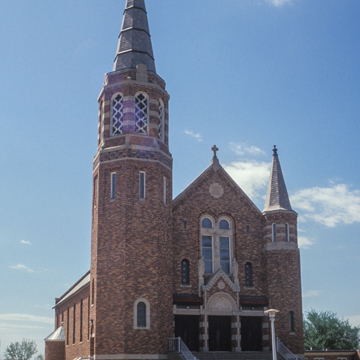When their first (1906) church burned, the German Russian parishioners of this community raised funds to rebuild in a style and interior opulence that reflected the earlier church. This church exhibits Romanesque Revival influence in its massive appearance relieved by narrow round-arched window openings. Two towers flank the gabled facade, one of which is massive and octagonal and the other round and slender. Both are topped by spires. Byzantine features include the use of polychrome ceramic tile and alternating brick and sandstone bands. Mosaic tile inlay creates a geometric pattern between the sandstone stringcourse and coping. The use of contrasting material increases the appearance of mass. Three sets of copper doors with quatrefoil motif panels form the entrance, and above the central door is a sandstone tympanum with the Virgin Mary carved in relief and surrounded by stylized carved ornamentation. The interior features elaborate stencil painting, profuse plaster statuary ornamentation, and painted round canvas ceiling panels. Four paintings on the projecting choir loft wall portray the history of St. Mary’s church. Seven tall stained glass windows portray the saints, and above each is a tiny, delicately painted angel face of plaster that projects from the wall. Ornate plaster statues form the ceiling rib corbels and the Stations of the Cross.
West of Hague at 96th Street SE and 17th Avenue SE is the historic St. Mary’s Cemetery (c. 1885) enclosed by a woven-wire fence and a wrought-iron gate. This cemetery is typical of the folk tradition of wrought-iron grave markers associated with German Russian cemeteries in the vicinity. Found exclusively in German Russian Catholic and Ukrainian cemeteries, the predominant burial marker is a cross, or eiserne kreuze, made at a local blacksmith shop with hand tools and using available iron and galvanized-metal parts. Forged into intricate and elaborate designs, rarely were two crosses fashioned alike. With graves dating from 1885 to 1915, this rural cemetery contains a representative sampling of iron cross markers by local makers.















